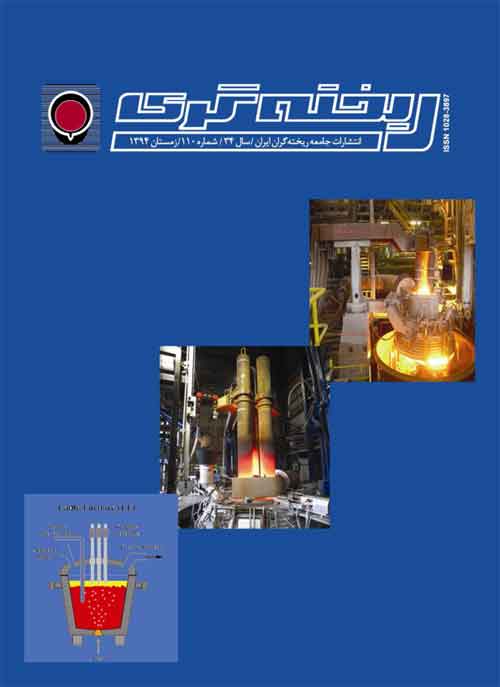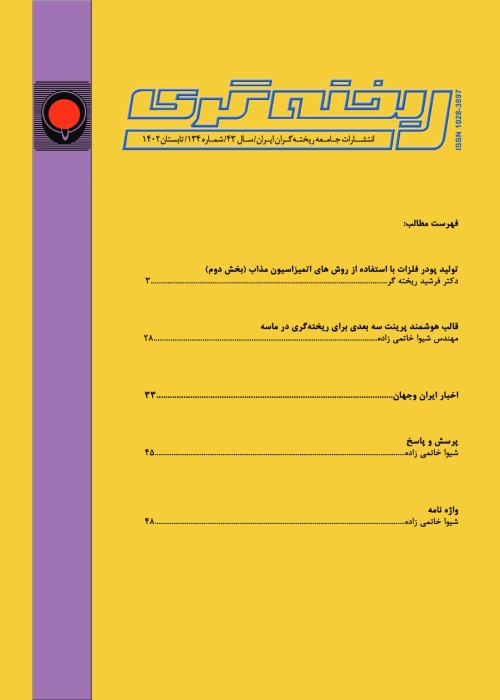فهرست مطالب

نشریه ریخته گری
پیاپی 110 (زمستان 1394)
- تاریخ انتشار: 1394/12/20
- تعداد عناوین: 9
-
-
بررسی ریزساختار اتصال بین لایه های برنز و فولاد در یاتاقان ژورنال تولید شده به روش ریخته گری گریز از مرکز افقیصفحه 1
-
طرح ریزی راهبردی برای بهبود عملکرد در آسیاهای گلوله ای سنگ آهن بهبود طول عمر دیافراگم های ورودی و خروجیصفحه 8
-
بررسی تاثیر ضخامت گیت بر تشکیل عیوب اقباضی در قطعه ریختگی چدن خاکستری از طریق شبیه سازی با نرم افزار MAGMA Softصفحه 16
-
بررسی تغییرات درصد تخلخل، ویژگی های ریزساختاری و مکانیکی آلیاژ Al-10 %Mg-X%Cuصفحه 26
-
بررسی تاثیر دمای فوق گداز برسختی و مقاومت به ضربه فولاد هدفیلدصفحه 37
-
بررسی علل تخریب پیچ های ماشین تونل زنی (TBM)صفحه 44
-
احیای مکانوشیمیایی همزمان اکسیدهای تیتانیم و وانادیم با استفاده از عامل احیاء کننده آلومینیوم جهت تولید آمیژان Al- Ti- Vصفحه 51
-
حذف کشیدگی در قطعات چدن خاکستری با کاهش انبساط گرافیتی درقالب های عمودی ماسه ایصفحه 59
-
فرآیند نیمه جامد مزایای مهمی دارد؛ بنابراین، چرا در کسب بازار گسترده تر ناموفق بوده است؟صفحه 68
-
Investigation of Bond Microstructure Between Bronze and Steel in Journal Bearings Manufactured with Horizontal Centrifugal CastingPage 1A way to overcome improper lubrication at machinery components having relative contact movement is application of bimetal and trimetal bearings. The purpose of this research is microstructure study at bond region and assessment of diffusion bond depth between steel CK22 backing and bronze UNS C93200 lining. Steel pipe has outer diameter 230 mm, inner diameter 205 mm and length 260 mm that is coated at inner surface through centrifugal force with 2 mm thickness. At this process first the bronze melt would pour in mold, then the part remains at rotation speed of 670 RPM and temperature of 1200 ℃ for 5 minutes while surrounding with Argon gas. Then it would be cooled at 15 minutes. Results show that diffusion bonding of steel to bronze occurs up to 24 depth from bond line. In this bond the Cupper element diffused up to 50% of primary density.Keywords: Diffusion process, Linear Scanning, Centrifugal, Dissimilar bond
-
Strategic Planning to Improve the Performance of Iron ore Ball Milling: Improve the Lifetime of Grate PlatesPage 8In this paper, strategic planning to improve the performance of dry ball milling in mill ore Golgohar is examined. Accordingly, a case study on the grate plates of the ball mill are carried out that are bottleneck parts subjected to sever wear and erosion. These parts are made by casting of high Cr steel alloy and longevity are less than 8 months. By studying the function and fauilar analysis of the made parts of four contractors (foundry company), internal and external reasons for poor performance related to the casting process, heat treatment, alloy design, microstructural and tribological analysises were dentified. Then the technology development roadmap to increase component lifespan has been recognized and presented in order of priority. In this regard for the first priority of the parts, minor adjustments to the chemical composition, solidification and heat treatment control condition are proposed. At the same time, the control of balls production is also emphasized. Accordingly, it is expected that with the implementation of the recommendations, grate plates function for at least 14 months.Keywords: Strategic Planning, Development, Ball Mill, Iron Ore, Casting, Wear
-
Investigation of effect thickness gate on formation shrinkage defects in grey cast iron casting by simulation with MAGMA softPage 16In this paper to predict the occurrence one of the major defects in grey cast iron casting which called shrinkage porosities, was used of the MAGMAsoft simulation software and was investigated filling and solidification parameters by it. Mentioned part was produced using vertical sand molding line (DISA 240B). The produced casting parts were contains significant defects of micro shrinkage because existence of hot spot into the casting part. The mentioned defect was investigated with Optical Microscopic (OM). To elimination of the formed shrinkage porosities, was changed the thickness of the gate. The new design gating system compare to the old pattern gating system. After investigation of the obtained results from simulation, it was observed that, with an increase to thickness of the gate lead to decrease solidification time of the gate and this factor lead to filling complete the mould and thus will be eliminated of the shrinkage porosities.Keywords: Grey cast iron, Shrinkage porosities, Hot spot, Gate, MAGMAsoft
-
Investigation of porosity variation, microstructural and mechanical properties of Al-10%Mg-X%Cu alloyPage 26In current study the effect of different amount of copper and artificial aging heat treatment was investigated on the microstructure and tensile properties of Al-10% Mg alloy. Copper with various contents (0.5, 1, 1.5, 2, 3, 4.5 %wt.) was added to the base alloy. Microstructural analysis showed that the addition of copper changes the dendritic morphology and also improves the tensile strength (up to a one percent). Electron microscopy analysis and outcomes of porosity analysis showed that by increasing copper content the interdendritic porosities was increased. It is worth mentioning that the increasing of porosities in the structure can be reasons of reduction in mechanical properties of the alloy in higher percentages of copper.Keywords: Porosity analysis, tensile properties, dendritic morphology, microstructure
-
Investigation on Effects of Melt Super-Heating Temperature on the Hardness and Impact Resistance of Hadfield SteelPage 37In this study, the effect of melt super-heating temperature on the microstructure and mechanical properties of Hadfield manganese steel have been investigated. For this purpose, initially four Y-shaped aluminum models prepared and then molding created through Sodium Silicate/CO2 and silica sand procedure as closed feeding. Super-heating temperatures 1350, 1400, 1450 and 1500°C considered for casting from coreless induction furnace. After the casting, every four blocks casted were quenched into the pure water bath. The optical microscopy method used to evaluate the microstructure of samples, Vickers hardness method used to evaluate their hardness, Charpy impact test used to evaluate the impact energy of samples, and uniaxial tensile used to evaluate strength of them. Optical microscopy observations showed that increasing superheating temperature, leads to decreasing precipitates and increases austenite grains size in the Hadfield steel microstructure. Mechanical tests results shows that increasing super-heating temperature leads to increasing strength, increasing hardness, reducing impact energy and reducing toughness in the Hadfield steel. According to the results of this research, according to toughness, the best super-heating temperature for Hadfield steel casting was 1350°C.Keywords: Hadfield steel, melt super-heating, mechanical properties, microstructure, casting
-
Failure Analysis of TBM ScrewsPage 44Failure of parts may be influenced by design, materials, process, production, incorrect application and environment or combination of these parameters. Thus, goal of studying failure analysis of parts is to specify each of aforementioned parameters and as a result, removal of imperfections. In this study, in addition to chemical analysis and hardness measurement of a TBM shield and tail shield screws, are checked out reasons of failure those screws with using macroscopic investigations and optical & scanning electron microscopy and is specified that in spite of observation corrosion voids, the screws are destroyed by torsion and bending overloads.Keywords: TBM, Screw, Bending, Torsion
-
Mechanochemical coreduction of titanium and vanadium oxides with Al for production of Al- Ti- V master- alloyPage 51The present work has been performed to investigate the simultaneous aluminothermic reduction of titanium and vanadium oxides to produce the AlTiV triple master alloy using mechanochemical reduction. For this reason, Powder mixture of Al, TiO2 and V2O5 as starting raw materials was used. The initial weight of each constituent was calculated considering the aluminothermic reaction of the corresponding oxides except that 30% excess aluminum reductant was used. Ball milling was performed in a highenergy planetary ball mill using balltopowder ratio of 10:1 and rotational speed of 300 rpm, for 2, 4, 8, and 12 hours using stearic acid as controlling agent. In order to investigate the effect of mechanical activation on the reduction rate, an activated sample for 12 hours was heated at 900℃ for two hours in the presence of fluorine flux. The reduction products were characterized using XRD analysis. The results showed the occurrence of the aluminothermic reduction, and the formation of the desired master alloy as well as titanium and vanadium aluminides. Increasing the milling time resulted in higher reduction fractions of the metals from their oxides. The thermal reduction of the activated sample showed an improvement as compared to an inactivated sample under the same conditions.Keywords: Aluminothermic reduction, flux, master alloy, ball?milling, high?energy planetary ball mill, X-ray Diffraction
-
Elimination of pull-down in grey cast iron with decrease graphite expansion at vertical sand mouldPage 59This study focuses on the cause of occurrence pull-down in grey cast iron casting to green sand mould. One kind of the flywheel part with 1 cm modulus was produced at a vertical green sand production line (DISA) with a mould with 350 × 770 × 600 mm dimension. Inoculation for formation (Atype) graphite performed by Sr-bearing inoculant. At the mass production, the casting parts containing significant pull-down defects were formed at upper section on the friction surface. For elimination of the pull-down defect at the mentioned part were carried out various tests such as change to the height of the pouring cup, strength and hardness of the mould, pouring temperature and amount of Carbon Equivalent (% CE). The height of the liquid area pouring to the pouring cup gating system relate to upper area of cavity was increases from 143 mm to 189 mm but not create any change in amount of pull-down defect. With decreasing temperature from 1400 to 1350 °C caused a significant decrease in pull-down defect from 60 to 23 %. Amount of pull-down was variable with change in hardness and strength mould. The only thing that leads to full elimination of the defect in this casting part, it was reducing the amount of carbon equivalent from 3.85 to 3.7 %wt. The effect of metallostatice pressure and remaining fraction solid in location of pull-down were investigated by MAGMAsoft.Keywords: Pull-down, Graphite expansion, Grey cast iron, Carbon Equivalent, green sand
-
SSM Provides Important Advantages;So, Why Has SSM Failed to Achieve Greater Market Share?Page 68Semi solid metal processing has numerous technical and economic advantages, such as viscous, non-turbulent flow (thus no air entrapment during casting), ability to fill ultra-thin sections (thus reduced part weight), little solidification shrinkage in the die (thus little or no porosity), minimum heat imparted to tooling (thus long tool life) and good response to T-5 aging (thus reduced heat treating costs). Still, SSM has never achieved a prominent position in the field of light metals casting Why? Perhaps the reason was largely the down economy of recent years and SSM will yet emerge with the prominence once expected of it.Keywords: SSM, thixocasting, rheocasting, SSM advantages, SSM barriers


